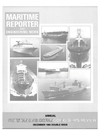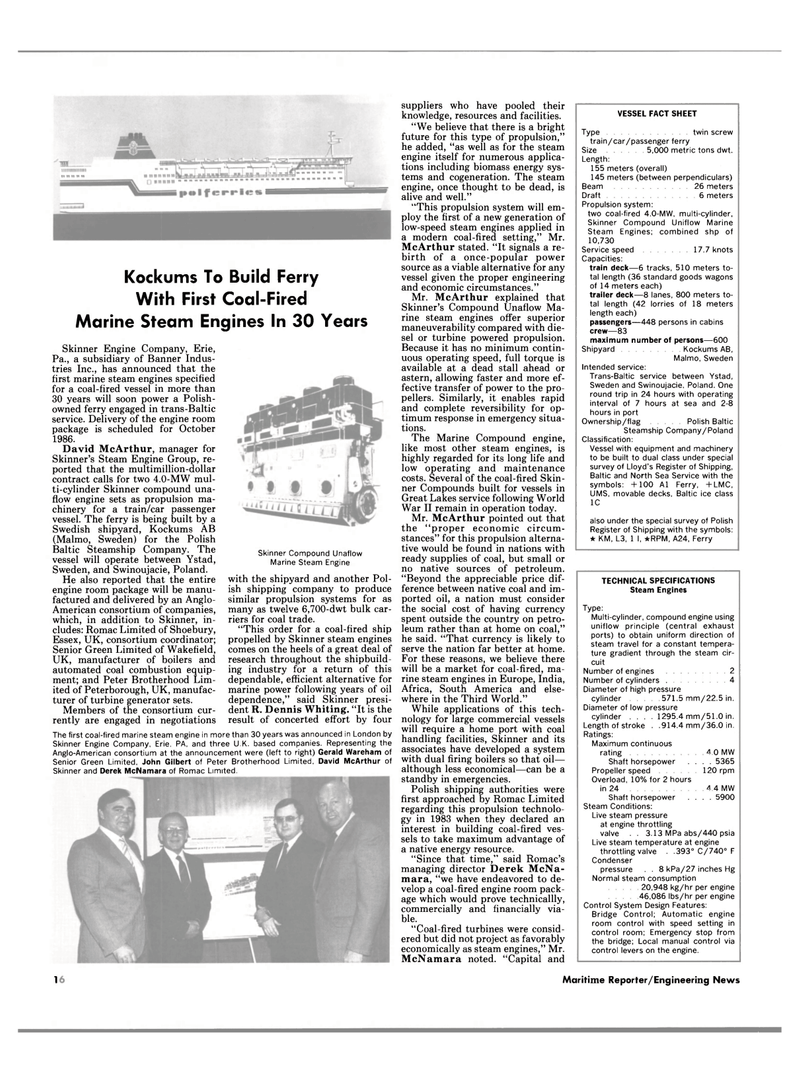
Page 14: of Maritime Reporter Magazine (December 1985)
Read this page in Pdf, Flash or Html5 edition of December 1985 Maritime Reporter Magazine
Kockums To Build Ferry
With First Coal-Fired
Marine Steam Engines In 30 Years
Skinner Engine Company, Erie,
Pa., a subsidiary of Banner Indus- tries Inc., has announced that the first marine steam engines specified for a coal-fired vessel in more than 30 years will soon power a Polish - owned ferry engaged in trans-Baltic service. Delivery of the engine room package is scheduled for October 1986.
David McArthur, manager for
Skinner's Steam Engine Group, re- ported that the multimillion-dollar contract calls for two 4.0-MW mul- ti-cylinder Skinner compound una- flow engine sets as propulsion ma- chinery for a train/car passenger vessel. The ferry is being built by a
Swedish shipyard, Kockums AB (Malmo, Sweden) for the Polish
Baltic Steamship Company. The vessel will operate between Ystad,
Sweden, and Swinoujacie, Poland.
He also reported that the entire engine room package will be manu- factured and delivered by an Anglo-
American consortium of companies, which, in addition to Skinner, in- cludes: Romac Limited of Shoebury,
Essex, UK, consortium coordinator;
Senior Green Limited of Wakefield,
UK, manufacturer of boilers and automated coal combustion equip- ment; and Peter Brotherhood Lim- ited of Peterborough, UK, manufac- turer of turbine generator sets.
Members of the consortium cur- rently are engaged in negotiations
Skinner Compound Unaflow
Marine Steam Engine with the shipyard and another Pol- ish shipping company to produce similar propulsion systems for as many as twelve 6,700-dwt bulk car- riers for coal trade. "This order for a coal-fired ship propelled by Skinner steam engines comes on the heels of a great deal of research throughout the shipbuild- ing industry for a return of this dependable, efficient alternative for marine power following years of oil dependence," said Skinner presi- dent R. Dennis Whiting. "It is the result of concerted effort by four suppliers who have pooled their knowledge, resources and facilities. "We believe that there is a bright future for this type of propulsion," he added, "as well as for the steam engine itself for numerous applica- tions including biomass energy sys- tems and cogeneration. The steam engine, once thought to be dead, is alive and well." "This propulsion system will em- ploy the first of a new generation of low-speed steam engines applied in a modern coal-fired setting," Mr.
McArthur stated. "It signals a re- birth of a once-popular power source as a viable alternative for any vessel given the proper engineering and economic circumstances."
Mr. McArthur explained that
Skinner's Compound Unaflow Ma- rine steam engines offer superior maneuverability compared with die- sel or turbine powered propulsion.
Because it has no minimum contin- uous operating speed, full torque is available at a dead stall ahead or astern, allowing faster and more ef- fective transfer of power to the pro- pellers. Similarly, it enables rapid and complete reversibility for op- timum response in emergency situa- tions.
The Marine Compound engine, like most other steam engines, is highly regarded for its long life and low operating and maintenance costs. Several of the coal-fired Skin- ner Compounds built for vessels in
Great Lakes service following World
War II remain in operation today.
Mr. McArthur pointed out that the "proper economic circum- stances" for this propulsion alterna- tive would be found in nations with ready supplies of coal, but small or no native sources of petroleum. "Beyond the appreciable price dif- ference between native coal and im- ported oil, a nation must consider the social cost of having currency spent outside the country on petro- leum rather than at home on coal," he said. "That currency is likely to serve the nation far better at home.
For these reasons, we believe there will be a market for coal-fired, ma- rine steam engines in Europe, India,
Africa, South America and else- where in the Third World."
While applications of this tech- nology for large commercial vessels will require a home port with coal handling facilities, Skinner and its associates have developed a system with dual firing boilers so that oil— although less economical—can be a standby in emergencies.
Polish shipping authorities were first approached by Romac Limited regarding this propulsion technolo- gy in 1983 when they declared an interest in building coal-fired ves- sels to take maximum advantage of a native energy resource. "Since that time," said Romac's managing director Derek McNa- mara, "we have endeavored to de- velop a coal-fired engine room pack- age which would prove technicallly, commercially and financially via- ble. "Coal-fired turbines were consid- ered but did not project as favorably economically as steam engines," Mr.
McNamara noted. "Capital and
The first coal-fired marine steam engine in more than 30 years was announced in London by
Skinner Engine Company. Erie. PA, and three U.K. based companies. Representing the
Anglo-American consortium at the announcement were (left to right) Gerald Wareham of
Senior Green Limited, John Gilbert of Peter Brotherhood Limited. David McArthur of
Skinner and Derek McNamara of Romac Limited.
VESSEL FACT SHEET
Type twin screw train/car/passenger ferry
Size 5,000 metric tons dwt.
Length: 155 meters (overall) 145 meters (between perpendiculars)
Beam 26 meters
Draft 6 meters
Propulsion system: two coal-fired 4.0-MW, multi-cylinder,
Skinner Compound Uniflow Marine
Steam Engines; combined shp of 10,730
Service speed 17.7 knots
Capacities: train deck—6 tracks, 510 meters to- tal length (36 standard goods wagons of 14 meters each) trailer deck—8 lanes, 800 meters to- tal length (42 lorries of 18 meters length each) passengers—448 persons in cabins crew—83 maximum number of persons—600
Shipyard Kockums AB,
Malmo, Sweden
Intended service:
Trans-Baltic service between Ystad,
Sweden and Swinoujacie, Poland. One round trip in 24 hours with operating interval of 7 hours at sea and 2-8 hours in port
Ownership/flag Polish Baltic
Steamship Company/Poland
Classification:
Vessel with equipment and machinery to be built to dual class under special survey of Lloyd's Register of Shipping,
Baltic and North Sea Service with the symbols: +100 A1 Ferry, +LMC,
UMS, movable decks, Baltic ice class 1C also under the special survey of Polish
Register of Shipping with the symbols: * KM, L3, 1 I, *RPM, A24, Ferry
TECHNICAL SPECIFICATIONS
Steam Engines
Type:
Multi-cylinder, compound engine using uniflow principle (central exhaust ports) to obtain uniform direction of steam travel for a constant tempera- ture gradient through the steam cir- cuit
Number of engines 2
Number of cylinders 4
Diameter of high pressure cylinder 571.5 mm/22.5 in.
Diameter of low pressure cylinder .... 1295.4 mm/51.0 in.
Length of stroke . .914.4 mm/36.0 in.
Ratings:
Maximum continuous rating 4.0 MW
Shaft horsepower .... 5365
Propeller speed 120 rpm
Overload, 10% for 2 hours in 24 4.4 MW
Shaft horsepower .... 5900
Steam Conditions:
Live steam pressure at engine throttling valve . . 3.13 MPa abs/440 psia
Live steam temperature at engine throttling valve . .393° C/740° F
Condenser pressure . . 8 kPa/27 inches Hg
Normal steam consumption 20,948 kg/hr per engine 46,086 Ibs/hr per engine
Control System Design Features:
Bridge Control; Automatic engine room control with speed setting in control room; Emergency stop from the bridge; Local manual control via control levers on the engine. 14 Maritime Reporter/Engineering News

 13
13

 15
15
